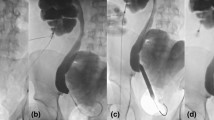Abstract
Our aim was to review our experience with percutaneous antegrade ureteric stent (PAUS) placement and to determine if the routinely conducted check nephrostogram on the day following ureteric stent placement was necessary. Retrospective review of patients who had undergone PAUS placement between January 2004 and December 2005 was performed. There were 83 subjects (36 males, 47 females), with a mean age of 59.9 years (range, 22–94 years). Average follow-up duration was 7.1 months (range, 1–24 months). The most common indications for PAUS placement were ureteric obstruction due to metastatic disease (n = 56) and urinary calculi (n = 34). Technical success was 93.2% (96/103 attempts), with no major immediate procedure-related complications or mortalities. The Bard 7Fr Urosoft DJ Stent was used in more than 95% of the cases. Eighty-one of 89 (91.0%) check nephrostograms demonstrated a patent ureteric stent with resultant safety catheter removal. Three check nephrostograms revealed distal stent migration requiring repositioning by a goose-snare, while five others showed stent occlusion necessitating permanent external drainage by nephrostomy drainage catheter reinsertion. Following PAUS placement, the serum creatinine level improved or stabilized in 82% of patients. The serum creatinine outcome difference between the groups with benign and malignant indications for PAUS placement was not statistically significant (p = 0.145) but resolution of hydronephrosis was significantly better (p = 0.008) in patients with benign indications. Percutaneous antegrade ureteric stent placement is a safe and effective means of relief for ureteric obstruction. The check nephrostogram following ureteric stent placement was unnecessary in the majority of patients.


Similar content being viewed by others
References
Finney RP (1978) Experience with new double J urethral catheter stent. J Urol 120:678–681
Reznek RH, Talner LB (1984) Percutaneous nephrostomy. Radiol Clin North Am 22(2):393–406
Banner MP (1989) Interventional radiology in the urinary tract. Current Imaging 1:10–20
Sharma SD, Persad RA, Haq A, et al. (1996) A review of antegrade stenting in the management of the obstructed kidney. Br J Urol 78(4):511–515
Hausegger KA, Portugaller HR (2006) Percutaneous nephrostomy and antegrade ureteral stenting: technique-indications-complications. Eur Radiol 16(9):2016–2030
Lu DS, Papanicolaou N, Girad M, et al. (1994) Percutaneous internal ureteral stent placement: review of technical issues and solutions in 50 consecutive cases. Clin Radiol 49(4):256–261
Hackethorn JC, Boren SR, Dotter CT, et al. (1985) Antegrade internal ureteral stenting: a technical refinement. Radiology 156(3):827–828
Patel U, Abubacker MZ (2004) Ureteral stent placement without postprocedural nephrostomy tube: experience in 41 patients. Radiology 230(2):435–442
Gillian MT Watson, Uday Patel (2001) Primary antegrade ureteric stenting: prospective experience and cost-effectiveness analysis in 50 ureters. Clin Radiol 56(7):568–574
Author information
Authors and Affiliations
Corresponding author
Rights and permissions
About this article
Cite this article
Soh, K.C., Tay, K.H., Tan, B.S. et al. Is the Routine Check Nephrostogram Following Percutaneous Antegrade Ureteric Stent Placement Necessary?. Cardiovasc Intervent Radiol 31, 604–609 (2008). https://doi.org/10.1007/s00270-007-9128-0
Received:
Revised:
Accepted:
Published:
Issue Date:
DOI: https://doi.org/10.1007/s00270-007-9128-0




